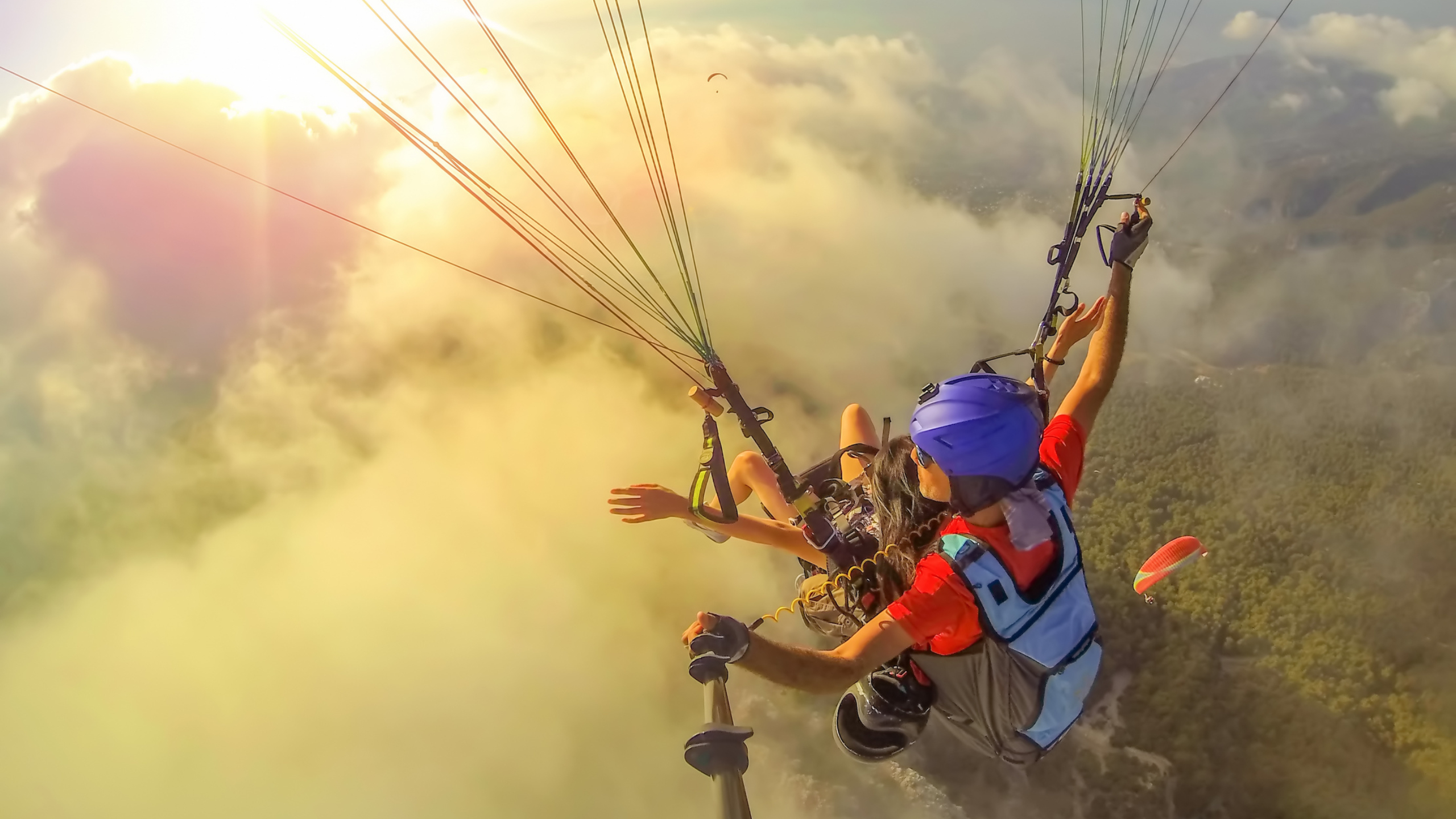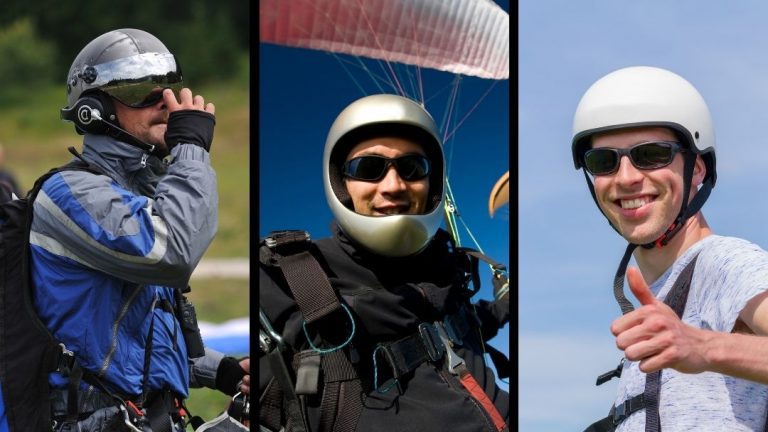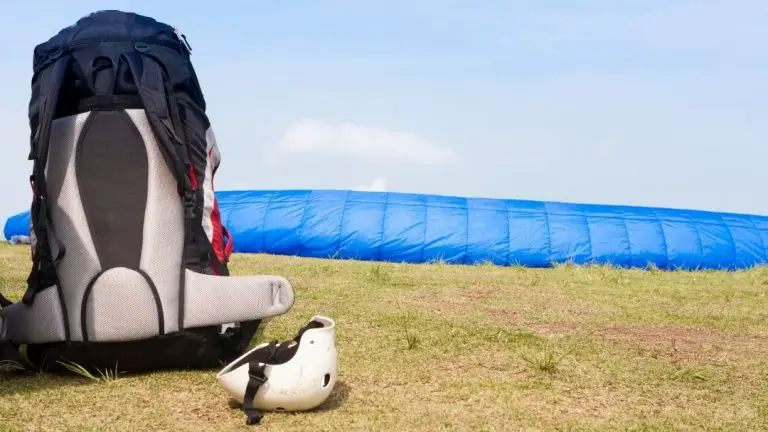Paragliding Harness Guide: Types and Buying Tips
Paragliding harnesses are more than just a comfortable seat for hanging out in, they are technical pieces of kit that play a key role in safety, how efficiently you fly, and how much feedback you get from your paraglider.
It is important to choose the right paraglider harness for you, your experience level, and your paragliding goals. We’ve put together this guide to help you distinguish between the different paragliding harness types and decide which is best suited to you.
What is a paragliding harness?
The paraglider harness is what connects the wing to the pilot.
The paragliding harness is like a swing seat that you strap into before flight. You attach the paraglider to the harness by connecting the risers (lines) of the paraglider to the carabiners of the harness.
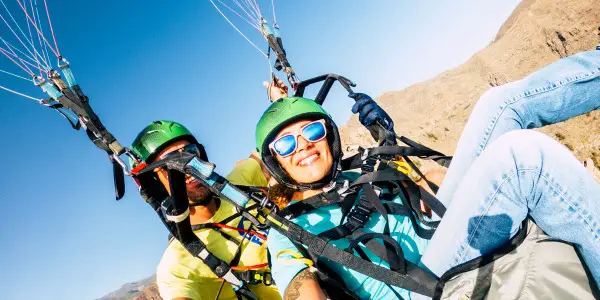
Made of heavy-duty fabric and adjustable straps for a customized fit, the paragliding harness is designed to be comfortable and give you a “feel” for the air, but it is also your primary piece of safety equipment while paragliding. Most harnesses include some form of back protection and have a special compartment for storing your reserve parachute.
Paragliding harness types: An overview
There is a vast array of paragliding harness types, but almost all harnesses have a few key characteristics in common. Harnesses can be classified as:
- an open vs pod harness,
- an airbag vs foam paragliding harness, and
- as a harness with vs without a seat board.
Open vs pod paragliding harness
All harnesses can be classified as either open or pod harnesses.
Open/upright harness
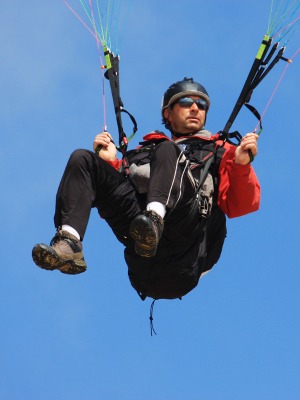
The open harness is also known as the classic, standard, or upright harness. It allows the pilot to sit in an upright posture, with their legs hanging free.
This paragliding harness type is great for beginners because you can easily get your landing gear (i.e., your feet and legs) down and ready for landing at a moment’s notice. For this reason, open harnesses are also used during training.
The classic harness is not only for beginners, however. Many experienced pilots still prefer the more upright posture of an open harness, even though this harness type is a bit less aerodynamic than the pod harness, resulting in slightly lower performance.
Pod harness
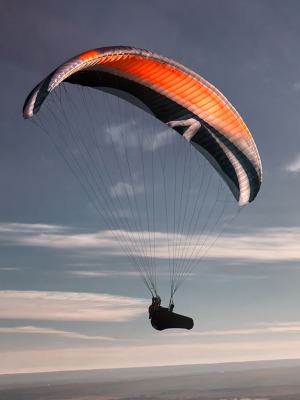
The pod harness allows you to fly in a more supine, or reclined, position, with your legs stretched out and your feet resting on a footplate or stirrup. This harness type encloses most of the pilot’s lower body in fabric and looks a little like a cocoon.
The main advantage of pod harnesses is that they give you a very aerodynamic shape, which reduces drag and increases your efficiency while flying. All that extra fabric around your legs also keeps you warm and comfortable while you’re up at cloud base.
However, pod harnesses are not recommended for beginners because they are a little more difficult to get into and out of (meaning your landing gear is a little more inaccessible), and they take some getting used to in the air.
Paragliding harness: Airbag vs foam
When it comes to a risky sport like paragliding, safety is of paramount importance.
The harness is your primary piece of safety equipment while paragliding. Most paraglider harness types include back protection, either in the form of an airbag or foam or a combination of both.
Airbag
The main advantage of airbag protection is that it cuts down on the weight, and bulk, of the harness.
This is an important point because lugging too-heavy paragliding gear up a mountain can tire you out, possibly leading to poor decision making in the air.
This type of protection does have some drawbacks, however. Traditionally, the airbag would only fully inflate after launch, meaning you would have no back protection if you were to be dragged while ground handling or if you had an accident shortly after takeoff, before the bag had inflated sufficiently to break your fall.
Some paragliding harness manufacturers have overcome this issue by designing airbags that pre-inflate before launch (such as this Advance paragliding harness), or that you can blow up like a balloon (such as this inflatable protection designed by Woody Valley).
Another disadvantage of this type of protection is that the airbag will only break your first impact with the ground, it won’t have enough time to reinflate and offer further protection after that. You can also puncture the airbag accidentally without realizing it, so you need to inspect it regularly.
Foam
Foam is a very basic, but effective, form of back protection. It is extremely reliable because it cannot be punctured or damaged easily, and it offers protection from the moment you strap into the harness.
For these reasons, foam is the type of protection most commonly found in paraglider training harnesses or for harnesses marketed at beginners.
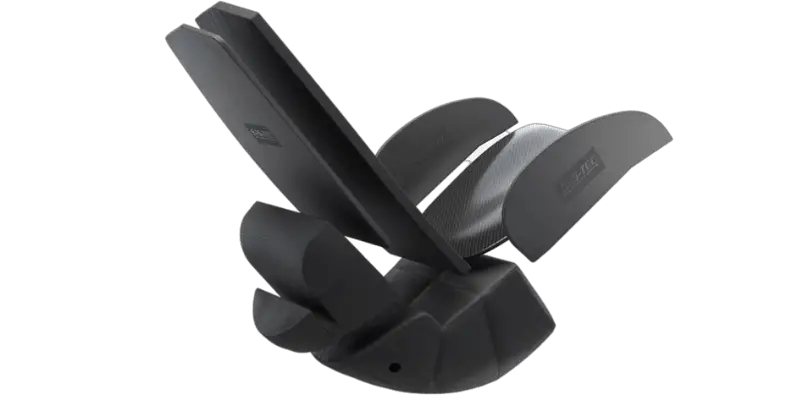
The only real drawback to foam protection is that it adds a significant amount of weight to your equipment, and it makes the paragliding harness bulky. This extra weight is fine if you can drive up to launch, but it can become tiresome if you’re traversing a mountain or you’ve landed miles away from your car.
How to decide, airbag vs foam?
This decision is largely down to your skills and personal preferences. If you’re a beginner pilot, or know that your ground handling skills are not up to scratch, then a harness with foam protection would probably be a better fit for you. If you know there is a very low chance of getting dragged on launch and you prioritize a lighter, smaller pack, then a harness with airbag protection would be ideal.
Seat board or hammock-style/split-leg seat
The final distinguishing characteristic of a harness is whether or not it has a seat board.
The seat board is generally made of wood or carbon fiber and provides a sturdy seat, similar to sitting in a chair. Seat boards are often used in paraglider training harnesses (like this Ozone paragliding harness) because the rigid board feels stable while paragliding and it allows for easy weight shifting.
On the other hand, some pilots prefer paragliding harnesses with a hammock-style or split-leg seat because they feel more connected to the air. Of course, this applies to turbulent air too, so these paragliding harness types can feel a bit too “rock and roll” for some.
Specialized paragliding harnesses
Paragliding harness manufacturers have designed many types of harnesses for specific types of paragliding.
Tandem paragliding harness
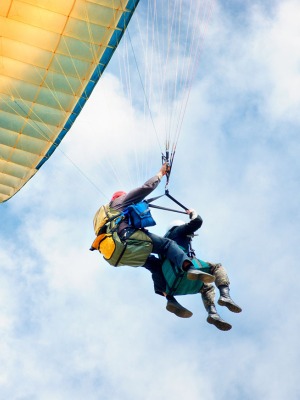
If your introduction to paragliding was to fly tandem as a passenger, then you have already encountered the tandem paragliding harness. It actually consists of two separate harnesses (one designed for the passenger, one for the pilot) connected by tandem spreader bars.
The passenger component of a tandem paragliding harness contains hefty protection for the lower back and beneath the seat. Some also have a replaceable base that is often included to protect the harness from scrapes during landing.
The pilot’s harness fits in neatly behind the passenger, with plenty of foam to protect both the pilot and passenger. The harness is also equipped with extra features that come in handy for a professional tandem pilot – such as a holder for a selfie-stick.
Paraglider training harness
Paraglider training harnesses are not all that different from standard harnesses: they are generally open/upright harnesses, with a seat plate for stability, and an extensive amount of foam back protection.
Training paragliding harnesses are ultimately designed to keep you as safe as possible while you’re getting to grips with how to control your paraglider, because there is a good chance you’ll get dragged a few times as part of your learning process.
Should you buy a harness before you start your training?
No, reputable paragliding schools will provide all the paragliding gear you need during your training. Once you are ready to leave the school environment, your instructor will be able to guide you in choosing which paragliding harness (and wing) would suit you and your abilities. The school will likely have demo harnesses and a test rig so that you can get a feel for different brands and types of paragliding harnesses.
Paraglider kiting harness
If you’re keen to practice your ground handling skills without risking scuffing up your usual harness, it could be worth considering a paraglider kiting harness for additional training.
These harnesses contain the bare minimum of straps required to connect you to your paraglider. They are designed for ground handling only, not for flying, so they won’t offer any back protection if you get dragged or “plucked and dumped” in strong winds.
Paraglider kiting harnesses are ideal for getting to know your wing at the local park, without having to lug your bulky harness around with you. It is worth bearing in mind, however, that the behaviour of your wing may feel slightly different with this type of harness than your usual one, so always be sure to practice ground handling with your standard flying kit too.
Is it worth buying a harness just for kiting?
If you don’t feel that a dedicated paraglider kiting harness is worth the additional expense, it could be worth checking if any members of your local paragliding club have an old paragliding harness for sale. Used paragliding harnesses are often sold off cheaply on eBay or elsewhere – try searching for “paragliding harness used.” Note that a lot of this old equipment won’t be airworthy, so if a harness is advertised as “for ground handling only,” or you cannot have it professionally inspected, then do not use it for flying!
*Paid Link
Hike-and-fly paragliding harness
When it comes to a hike and fly paragliding harness, cutting down on weight is key. Even if hike-and-fly isn’t your cup of tea, a light paragliding harness makes it far easier to travel with your gear.
Ideally, your hike and fly paragliding harness should be as light and as compact as possible to make it easier to haul your gear up mountains and across difficult terrain, but preferably without jeopardizing performance or safety.
Hike and fly paragliding harnesses are often marketed as reversible paragliding harnesses, lightweight paragliding harnesses, or even ultralight paragliding harnesses.
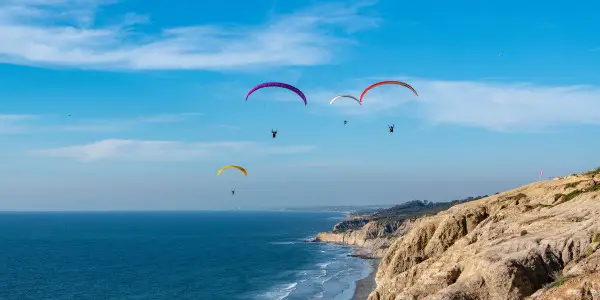
Reversible paragliding harness
Reversible harnesses double as both a paragliding harness and as a rucksack to store all of your gear – this eliminates the need for a separate rucksack, thus reducing the overall weight of your equipment and making it much more compact.
Although many reversible paragliding harnesses are manufactured from the same sturdy material and with the same levels of protection as standard harnesses, some are made from thinner material to keep the paragliding harness light, reducing the pack weight even further.
A disadvantage of the reversible paragliding harness is that it is naturally more exposed to wear and tear (during travel, for instance) than it would be if you used a separate rucksack.
Lightweight paraglider harness
Lightweight paragliding harnesses are generally designed similarly to standard harnesses, but are made from a thinner material and include an airbag rather than foam protection.
Although a lightweight paraglider harness may have similar safety features to a standard harness, the material will not withstand the same kind of abuse as its more heavy-weight counterpart.
Ultralight paragliding harness
With an ultralight paraglider harness, every effort is made to reduce weight at all costs. These harnesses are constructed using a very thin material, and their straps and buckles are incredibly minimalistic.
An ultralight paragliding harness may not have any form of back protection or even a compartment for a reserve parachute, as is the case with this Ozone paragliding harness that weighs a mere 102 grams (0.22 lb). These harnesses are for the most serious, experienced pilots only.
What are the downsides of a light paragliding harness? Lightweight materials are more prone to tears and damage, so these harnesses may not last as long as standard ones. If you use this type of gear, be sure to inspect it regularly and take particular care on rocky launch sites.
Acro paragliding harness
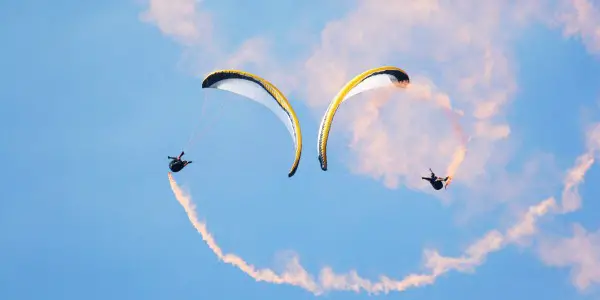
The acro paragliding harness is used for aerobatic flying. These are open harnesses designed for precise control in the air and include the additional safety measures needed for this type of paragliding.
Because of the extreme nature of acro, an acro paragliding harness usually has two reserve containers and may also have a quick-release system so that you can quickly ditch the main wing if, for example, your paraglider gets tangled up in the lines of one of the reserve parachutes.
What is acro paragliding?
Acro (short for acrobatic) is an extreme, high-adrenaline subspecialty of paragliding. Acro pilots perform controlled aerobatic stunts (often at very high G-forces), such as the deep spiral, infinity tumble, helico, and tailslide. This type of paragliding is thrilling to watch, but best left to the experts.
Tips for buying a paraglider harness
There are many paragliding harness manufacturers, all producing a wide range of harnesses. Which paragliding harness is right for you will depend on:
- Your experience level – beginner pilots should choose a harness with high levels of passive safety, such as a harness with foam protection or at least an airbag that pre-inflates before launch.
- Your paragliding goals – cross-country pilots may prefer a pod harness to maximize their performance and comfort while flying for hours, while pilots more interested in hike-and-fly would be better suited to a lightweight harness.
- Your personal preference and fit – ideally, you should get the feel for several harnesses and choose the one that fits your body and goals best.
Should you buy a new or used paragliding harness?
A major advantage of buying a new harness from a reputable dealer or paragliding school is that you can get advice from the experts and be assured that the paraglider harness is airworthy. Most paragliding dealers and schools will let you use their harness testing rigs to get a feel for different harnesses and see which is most comfortable for you.
The dealer/instructor can also help you set up the harness correctly: the carabiners need to be at a set distance apart and most paragliding harnesses have adjustable webbing for a personalized fit. On the other hand, if you are experienced and have a good idea of the brand and style of paragliding harness that would be right for you, you could find a decent second-hand paragliding harness for sale at a good price. If you venture down the used paragliding harness route, however, be sure to have the harness inspected by an expert if you lack the experience to do this yourself.

